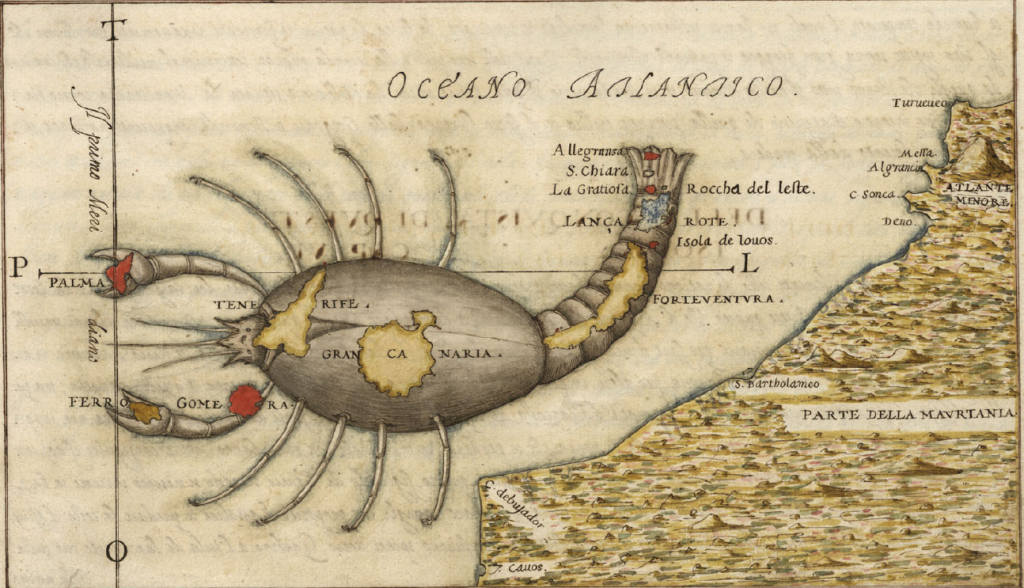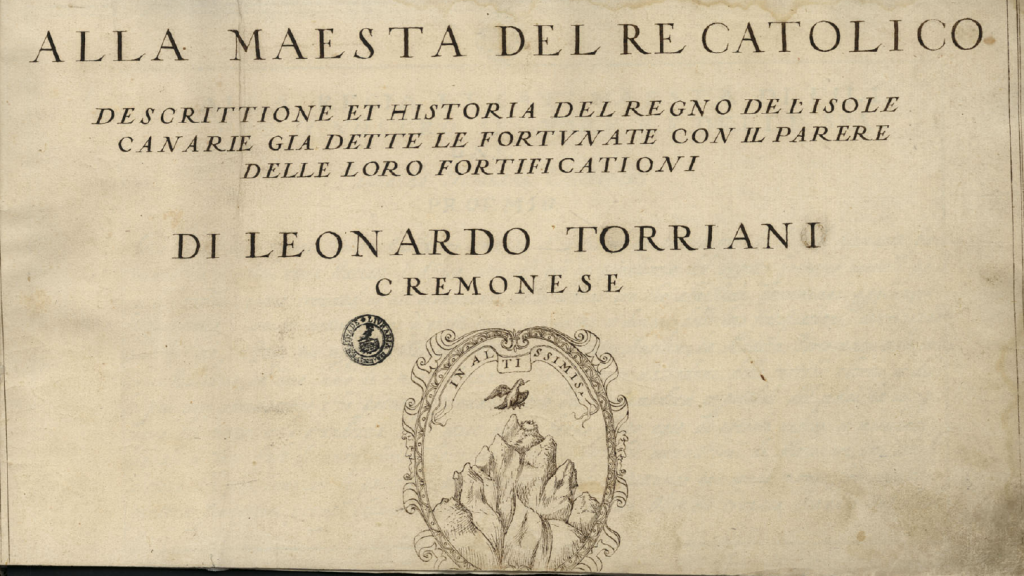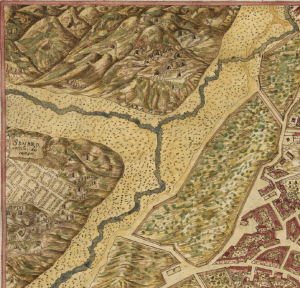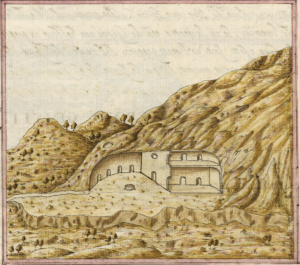
The notorious map of the Canary Islands related to the zodiacal sign of Cancer, by Engineer Leonardo Torriani in the late sixteenth century (source: Biblioteca Geral da Universidade de Coimbra, catalogue number Ms. 314, folio 8r.)
In 1584, King Philip II of Spain commissioned one of his trusted technicians, Engineer Leonardo Torriani (Cremona, Duchy of Milan, c 1560 -. Coimbra, Kingdom of Portugal, 1628), to design and build a keep and a dock on the island of La Palma. This mission, which lasted about two years, was extended by re-hiring the Cremonese in 1587 to carry out a more ambitious project: the inspection of all defensive infrastructure of the Archipelago with the drafting of a comprehensive report on them including expansion and reform proposals.
His stay in the Archipelago lasted about twelve years, until 1596, during which he was provided with the opportunity to acquire a deeper insight on various aspects of its culture and history. Fortunately, in line with the prevailing Baroque style in Italian culture, Torriani judged a simple technical report would be too arid for the monarch’s taste:
Having been ordered by Your Majesty, in past years, to make the description of the Canary Islands, I felt such small lands, detached from Africa and so lonely, by the smallness of the case, could not be more than scarcely welcomed by Thou. And so, finding in the monuments of letters how to embellish them, I determined myself to add the story and events that happened on them, until our times, with the views and drawings of their strongholds.[1]TORRIANI (1959), p. 1. This translation by PROYECTO TARHA.

The manuscript’s front cover (source: Biblioteca Geral da Universidade de Coimbra, catalogue number Ms. 314).
So begins this important document whose translated title is, To the Majesty of the Catholic King, Description and History of the Kingdom of the Canary Islands, formerly Fortunate, with the views of its fortifications. The original manuscript in Italian[2]Possibly, a compilation by Torriani’s own hand prepared from partial reports -TORRIANI (1959), p XXIV-. and its digitizations are preserved in Portugal:
- Biblioteca Geral da Universidade de Coimbra, catalogue number Ms. 314:
This work’s value lies not only in the description of the main towns of the Islands, as they appeared before the eyes of the engineer in the late sixteenth century, but also in the inclusion of ethnohistoric passages with new details about the indigenous world accompanied by suggestive drawings –blueprints, elevations, indigene portraits, landscapes, etc.–, unprecedented in the Canarian historiography and that we will certainly outline in future articles.

The indigenous settlements of Tara and Sendro, on the western edge of the city of Telde (Gran Canaria), in the late sixteenth century (source: Biblioteca Geral da Universidade de Coimbra, catalogue number Ms. 314, folio 64v.).
As for his sources, Torriani himself claimed to have been served by a number of manuscripts and testimonies. Among the former, his testimony on using one of the lost histories of the Canary Islands outstands, the one written by Dr. Antonio de Troya, possibly a reference in common to Brother Juan de Abreu Galindo and Brother Alonso de Espinosa.[3]TORRIANI (1959) , pp. XXXI-XXXVII, 214.

Indigenous cave house in Gran Canaria, according to Leonardo Torriani. Note the similarity of certain building details, such as the small lighting window opened on the hillside, with those at Risco Caído (source: Biblioteca Geral da Universidade de Coimbra, catalogue number Ms. 314, folio 34r).
The edition we recommend here, besides the colorful, beautiful original manuscript, is a Spanish translation published in 1959 by Professor Alejandro Cioranescu and whose download link we point out in the references section.
Antonio M. López Alonso
References
- Torriani, L. (1590). Alla Maesta del Re Catolico, descrittione et historia del regno de l’isole Canarie gia dette le Fortvnate con il parere delle loro fortificationi Di Leonardo Torriani cremonese. Coimbra (Portugal): Biblioteca Geral da Universidade de Coimbra.
- Torriani, L. (1959). Descripción e historia del reino de las islas Canarias antes Afortunadas con el parecer de sus fortificaciones. Traducción del Italiano, con Introducción y Notas, por Alejandro Cioranescu. Santa Cruz de Tenerife: Goya Ediciones.

Pingback: El Hierro : l'arbre fontaine, de las Casas (XVIe s.) à Dominik Wölfel (1940), par Alain Gioda
Pingback: El Hierro : le nouvel arbre fontaine et Leoncio Oramas Diaz-Llanos (1947-1948), par Alain Gioda